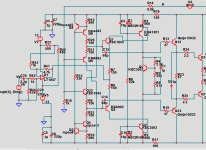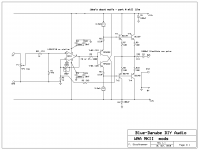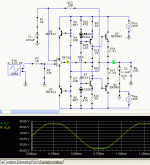With all the repairs you do, I'm sure you recognize this schematic. Yes, at 70+ volts, it can put out 250W.
I left out the protection and compensation. More must be done for a final amp. First step is to show the amp can swing full voltage.
Some of the things I really like about opamp front end are no requirement for matched differential transistors and output DC offset is almost zero.
I left out the protection and compensation. More must be done for a final amp. First step is to show the amp can swing full voltage.
Some of the things I really like about opamp front end are no requirement for matched differential transistors and output DC offset is almost zero.
The double Vbe on the mbl 8006 clone should not be a problem. The point between the two Vbe (output of opamp) is floating with respect to the amp's output. Because of that, the bases of the output transistors see it as one Vbe.
If the point between the two Vbe is referenced to the amp's output, each Vbe will then control only one half. Top Vbe for upper transistors, lower Vbe for lower transistors. Obviously, this will create a very difficult situation.
If the point between the two Vbe is referenced to the amp's output, each Vbe will then control only one half. Top Vbe for upper transistors, lower Vbe for lower transistors. Obviously, this will create a very difficult situation.
well Michael ....you must be a very nice guy !!!! Nice of you to spent so much time in a terrible circuit ...
Thing is that i never had an MBL 8006 to repair so have also the chance to study it ...same with the MBL i produced many amplifiers that worked quite well on the bench but still never tryied them in real life conditions since i was to afraid to push them arround with expensive ( probably ) speakers ..
That will be the chameleon clone ... some quasi boards i ve made and also the P68 from Rodd
had them all made, tested, also made some inproovemnts here and there but never ( yet) pushed them hard to see what will happen ....
Its a question of time and afortability to "loose" one amplifier in a gig ..
I could as well crow bar them all and wire them up in a hot swaping topology to see how far i will go with them ...
Will do a test like that some day
Thing is that i never had an MBL 8006 to repair so have also the chance to study it ...same with the MBL i produced many amplifiers that worked quite well on the bench but still never tryied them in real life conditions since i was to afraid to push them arround with expensive ( probably ) speakers ..
That will be the chameleon clone ... some quasi boards i ve made and also the P68 from Rodd
had them all made, tested, also made some inproovemnts here and there but never ( yet) pushed them hard to see what will happen ....
Its a question of time and afortability to "loose" one amplifier in a gig ..
I could as well crow bar them all and wire them up in a hot swaping topology to see how far i will go with them ...
Will do a test like that some day
light years ahead !
Yes , mike is a nice guy (my first "project" was an ampslab one).
Even as one who does not like IC driven power amps , there are MUCH better way's to do the deed.
The best low voltage IC solution was from one of our departed Guru's (below 1). OP-amp does half the voltage gain (5X) , the folded cascode push- pull OP stage has another 7X. OP can also be globally fed back to IC , many "flavors" of this circuit - they all work.
For the high voltage IC's , a simple diamond buffer (below 2 - simplified example) or more advanced buffer (nakamitchi) will be more than sufficient. Both blow the thread circuit out of the water , flirting with .001%/ 20K.
Except for true complimentary IPS's , just a DMM matched pair will usually equate to <5mv offset. Many IC's are not perfect , needing a tweak of the "offset null" pins. Of course ,they do eliminate 10 -20 semi's
OS
Yes , mike is a nice guy (my first "project" was an ampslab one).
Even as one who does not like IC driven power amps , there are MUCH better way's to do the deed.
The best low voltage IC solution was from one of our departed Guru's (below 1). OP-amp does half the voltage gain (5X) , the folded cascode push- pull OP stage has another 7X. OP can also be globally fed back to IC , many "flavors" of this circuit - they all work.
For the high voltage IC's , a simple diamond buffer (below 2 - simplified example) or more advanced buffer (nakamitchi) will be more than sufficient. Both blow the thread circuit out of the water , flirting with .001%/ 20K.
Some of the things I really like about opamp front end are no requirement for matched differential transistors and output DC offset is almost zero.
Except for true complimentary IPS's , just a DMM matched pair will usually equate to <5mv offset. Many IC's are not perfect , needing a tweak of the "offset null" pins. Of course ,they do eliminate 10 -20 semi's
OS
Attachments
There seems to be a twist in the tale. Look at the op-amp supply, it is modulated by the amp output. The supply rails for the op-amp although at a fixed voltage is sliding between the amp rails therefore it can swing close to the amplifier rails. Correct me if I am wrong.
What Sakis say about oscillation may be worth looking at, or it can be that the gain of the Vbe multiplier for that particular channel is on the low end of what is expected as typical.
What Sakis say about oscillation may be worth looking at, or it can be that the gain of the Vbe multiplier for that particular channel is on the low end of what is expected as typical.
I was about to point this out 
I remember reading about another similar amplifier, the Audio Analogue Puccini. It looks like much the same thing except with active devices instead of a simpler resistor-zener arrangement for the sliding supplies.
The attraction to using an opamp frontend for me was that FETs bring many advantages, but good audio fets are practically unobtanium. However good FET input opamps like the OPA2134 are easily obtainable. A current feedback arrangement as detailed in the Alexander amplifier (Analog Devices AN-211) works well in simulation
I should really stop dickering about and make something ! (well I made a gainclone, but that doesnt count
I remember reading about another similar amplifier, the Audio Analogue Puccini. It looks like much the same thing except with active devices instead of a simpler resistor-zener arrangement for the sliding supplies.
The attraction to using an opamp frontend for me was that FETs bring many advantages, but good audio fets are practically unobtanium. However good FET input opamps like the OPA2134 are easily obtainable. A current feedback arrangement as detailed in the Alexander amplifier (Analog Devices AN-211) works well in simulation
I should really stop dickering about and make something ! (well I made a gainclone, but that doesnt count
- Status
- This old topic is closed. If you want to reopen this topic, contact a moderator using the "Report Post" button.
- Home
- Amplifiers
- Solid State
- Bias Drifting Higher?


